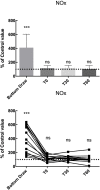Nitric Oxide and Oxidative Stress Changes at Depth in Breath-Hold Diving
- PMID: 33488400
- PMCID: PMC7818785
- DOI: 10.3389/fphys.2020.609642
Nitric Oxide and Oxidative Stress Changes at Depth in Breath-Hold Diving
Abstract
Background: Several mechanisms allow humans to resist the extreme conditions encountered during breath-hold diving. Available nitric oxide (NO) is one of the major contributors to such complex adaptations at depth and oxidative stress is one of the major collateral effects of diving. Due to technical difficulties, these biomarkers have not so far been studied in vivo while at depth. The aim of this study is to investigate nitrate and nitrite (NOx) concentration, total antioxidant capacity (TAC) and lipid peroxidation (TBARS) before, during, and after repetitive breath-hold dives in healthy volunteers.
Materials and methods: Blood plasma, obtained from 14 expert breath-hold divers, was tested for differences in NOx, TAC, and TBARS between pre-dive, bottom, surface, 30 and 60 min post-dive samples.
Results: We observed a statistically significant increase of NOx plasma concentration in the "bottom blood draw" as compared to the pre-dive condition while we did not find any difference in the following samples We found a statistically significant decrease in TAC at the bottom but the value returned to normality immediately after reaching the surface. We did not find any statistically significant difference in TBARS.
Discussion: The increased plasma NOx values found at the bottom were not observed at surface and post dive sampling (T0, T30, T60), showing a very rapid return to the pre-dive values. Also TAC values returned to pre- diving levels immediately after the end of hyperbaric exposure, probably as a consequence of the activation of endogenous antioxidant defenses. TBARS did not show any difference during the protocol.
Keywords: breath-hold diving; diving; free radicals; nitric oxide; oxidative stress.
Copyright © 2021 Cialoni, Brizzolari, Samaja, Bosco, Paganini, Pieri, Lancellotti and Marroni.
Conflict of interest statement
The authors declare that the research was conducted in the absence of any commercial or financial relationships that could be construed as a potential conflict of interest.
Figures




References
-
- Arborelius M., Jr., Ballidin U. I., Lilja B., Lundgren C. E. (1972). Hemodynamic changes in man during immersion with the head above water. Aerosp Med. 43 592–598. - PubMed
-
- Ashcroft F. M. (2002). Life at the Extremes: The Science of Survival. London: Harper Collins.
LinkOut - more resources
Full Text Sources
Other Literature Sources

